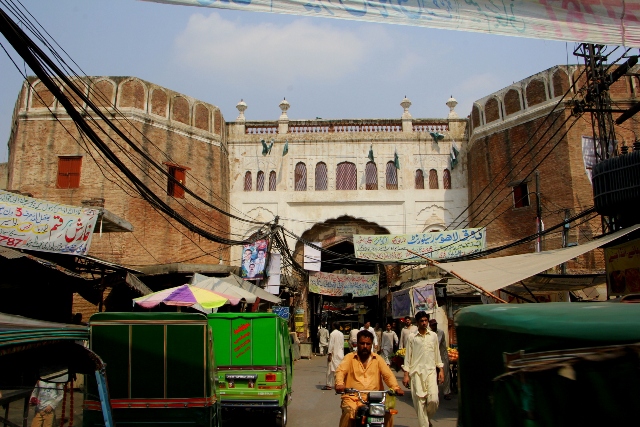This was my fifth visit to the same place to resolve my
mystery about the Noori building, popularly known as Noori Manzil inside the
famous Lohari Gate, Walled City of Lahore, near Mohalla Peer Shirazi.
Every time I had visited the place I was informed by the locals that some parts
of it were haunted. It was not actually the fear that stopped me going inside
there, but seeing a female alone, I was not allowed to enter the building. It
took me all these visits to convince the family living in one part of the
building and finally the fifth time I could photograph it, as I had a male
friend along, whom the family thought would guard me! Well, the family was kind
enough to call a local person to guide us into the haveli.
There started my excursion! I entered through a narrow dark doorway which
led me into a reasonably larger courtyard, as usually we do not find open
spaces and courtyards inside the walled city; it’s a rare feature now. No
wonder the building façade was mesmerizing and captured my senses for few
seconds. Till then I could not smell any hex or vex there. It was a wrecked
beauty, but still staggering. I believe (from what I observed) it was a living
area between the two sections of the building. It had turned into a courtyard
as the roof had collapsed over the passage of time and I am sure it was
neglected. The local person Akhtar guiding us seemed nervous right from the
first step. Along the sides of this courtyard were the main buildings structures
decorated with carved and brick balconies reflecting Sikh Architecture. The
lined designs are a prominent feature of Sikh Architecture which was visible
all over the building. Probably, it was a Sikh era construction.
I entered in one of the portions of the building on the
right and I was lost into the majesty of the ruins. It was undoubtedly a
masterpiece. The interior was spellbinding and mysterious. Now, for a moment I
was scared and the local along us must be coveting to hammer us out, but again our
curiosity won. The main area inside this double storey portion of the Haveli had
a small square courtyard with rooms around it. It was an abandoned Haveli and
some shoe makers had occupied two rooms on the ground floor. Other rooms were
locked since ages as the manes were rusted. The building was awfully dilapidated with
pigeons all around and debris on the floor. Some parts were covered with bird
droppings which gave a snowy look! I wondered why nobody ever thought to
maintain it. It is a piece not less than any other Haveli inside the walled
city; it is just ignored and blamed as being haunted. I didn’t feel anything in
there.
The Noori Manzil, was a doll house but in fiasco. I thought
to go on the upper floor but the local man tried to stop me. Finally after a
long argument I managed to reach the first floor which was actually derelict
and with my each step it quivered. Well, there I was a little frightened and
most of the pictures I took were blurring.
The huge cracks narrated how ruthlessly the building was kept and
treated. Each brick falling apart cried. The railing running around the upper floor
was dusty rather grubby. The walls of the Haveli were carved, and brick work in
paisley design was used as a border everywhere.
The structure of the building seemed strange to me, but I
could relate it with the Haveli of Nau Nehal Singh (Victoria School). I asked
Akhtar, if I could get any history of the place or if the family living in it
could tell me something. He took me to the family again. There I met more women
and lots of children playing in a dark room maybe that was the load shedding
time. The ladies, a little hesitant in talking to me, later narrated the whole
story. The head of the family was working abroad and according to them they did
not have sufficient income to maintain the building, so they left it falling
apart.
According to the residents, the haveli was a house of
dancing girls during the Sikh period. It was built by a prostitute /dancer
“Poori Bai” and the Haveli was known as Poori Haveli at that time. As the time
passed, the haveli, like many other streets and gates of the walled city, was
renamed to Noori Haveli or Noori Manzil. The Haveli was a two storeyed building
with thirty two rooms. I couldn’t get a chance to see all the rooms as one
portion was completely locked and other rooms were closed as well. There was a
stable for horses which was now converted into shops in which the shoe makers
were sitting. According to the residents the occupied area of the Haveli was 27
Marlas, which is considered huge inside the walled city at present. It was
allotted to the family after the partition in 1947 when the Sikhs moved out.
According to history
books, the red light area was located inside the Lohari Gate before the Sikh
rule and most of the affluent prostitutes/ dancers had built beautiful Havelis in
Lohari. The famous Chowk inside the Lohari Gate, Chowk Matti was also named
after a prominent prostitute “Matti Bai”. With the passage of time, the Red
Light area was shifted to Chowk Jhanda, then Tibbi Gali and eventually spread
over the Heera Mandi.
The Haveli is no doubt a masterpiece and a hidden jewel
inside Lohari Gate Lahore. The residents are not financially sound to restore
or maintain it. I hope it is not lost into commercialization till my next
visit.
(The writer is a media professional and can be reached at taniaq29@gmail.com)

































